
Lovers Abelard and Heloise
Some historians maintain that the Middle Ages gave birth to the idea of romantic love. Historical figures and lovers Abelard and Heloise serve as icons of medieval romantic love. Theirs was not the distant infatuation of knight for unattainable lady, however, or dewy- eyed heroine for valiant hero. Rather, their love story contained brilliant and inquisitive minds, mutual respect and admiration, unbridled passion, heights of ecstasy, consummated eros, violence, tragedy, separation, salvation through love and service, and a lifelong bond.
Of a 12th century French noble family, Abelard disavowed knighthood in favor of a life of learning and letters. He became famous for his knowledge, scholarship, and facility of discourse. We also sense his charisma and compelling physical presence. Of lesser blood, Heloise was widely renowned in France for her abilities of reading and writing, as well as her disdain of marriage and traditional feminine roles. Abelard later maintained he was drawn to the accomplished young woman and persuaded her uncle, an ecclesiastic, to allow him to move into his house, offering to tutor her in exchange. Heloise could have been as young as seventeen or as old as her mid-twenties. Regardless, the unusual and lively pair experienced a mutual attraction and soon fell into passionate love.
When Heloise became pregnant, Abelard sent her to his sister, where she gave birth to a boy, Astrolabe. Heloise’s uncle insisted the couple be married. Heloise objected but finally relented, and Abelard also agreed. To protect his career, however, he insisted the marriage remain secret. The spread of gossip, fueled by her uncle, led Abelard to place Heloise in the convent where she had been raised. Consequently, a band of her uncle’s friends attacked Abelard and castrated him. Following that, he became a monk, and Heloise, at his urging, took a nun’s vows and eventually became an abbess.

“She shows us that the womanly, purely human experience of love for a specific living being and the courage to burn for that love were to be the kingdom and the glory of properly human life.”
Abelard’s legacy in history is assured as that of a philosopher, logician, and theologian. Heloise’s legacy lives on, too, as the highly competent head of an abbey and skilled physician in that role. Most of all, however, we remember their great love. We know it through the letters they wrote to each other years later as abbot and abbess and through the descriptions of numerous poets and writers since.
Heloise wrote to him: “Remember (for nothing is forgot by lovers) the time and place in which you first declared your passion and swore you would love me till death. Your words, your oaths, are deeply graven in my heart.”
Here are some of his words to her: “This, unhappy Heloise, is the miserable condition of Abelard. The world, which is generally wrong in its notions, thinks I am at peace, and imagining that I loved you only for the gratification of the senses, have now forgot you. What a mistake is this!”
I love the line from Alexander Pope’s poem about them where Heloise implores Abelard: “Suck my last breath, and catch my flying soul,”
What do you think of lovers Abelard and Heloise?
 Cheers & Happy Reading!
Cheers & Happy Reading!
Flossie Benton Rogers, Conjuring the Magic with Paranormal Romance
A tragic yet beautiful story from so long ago. A passion cruel events didn’t kill is a reminder of the incredible power of emtion and it’s impact on lives. Thanks for posting this, Flossie.
You are so right, Daisy. What incredible power emotion has over us but also within us.
I have to admit I’ve never heard of these two, but their story is indeed both tragic and beautiful. I love the line “…catch my flying soul.” Thanks for sharing their story, Flossie!
That is an incredible line from an under appreciated poet these days, Mae. I’m glad to share the story of Heloise and Abelard.
A tragic romance closer to what happens so often in real life.
Thank you for sharing it, Flossie. I’ve never heard about this couple that should be rightfully placed next to Romeo and Juliette, or other tragic couples.
That’s a great point, Carmen– how it’s closer to real life than many stories. I do think of them along with Romeo and Juliet, Tristan and Isolde.
Very Big Sigh!
Indeed. Thanks, Loretta.
I’m so glad to have caught a tweet about this post. Such a tragic love story! They are now together in death, their bodies entombed in Pere Lachaise in Paris. I visited the cemetery a few years ago. People from all over the world now leave love notes on the gates around the tomb. I couldn’t leave a picture in my reply, but you can see my photographs here http://lindaksienkiewicz.com/pere-lachaise/. I also added a link back to your post in case people want to read more! Thank you!
Linda, I’m thrilled to meet a fellow writer and especially an Abelard/Heloise supporter. I have updated my post with a link to your website. How fabulous that you visited their tomb. I love the photographs!
I learn something new here every week! beautiful yet tragic story. I tend to love those kinds of love!
Thank you for saying that, Cathy!